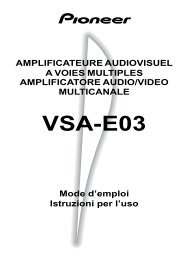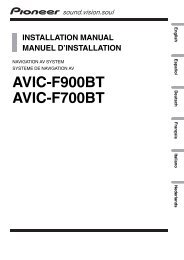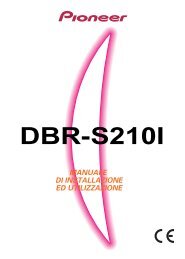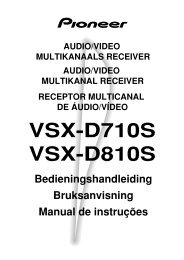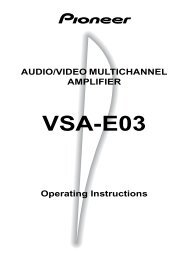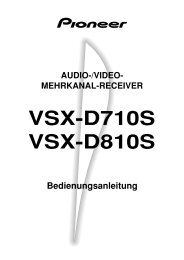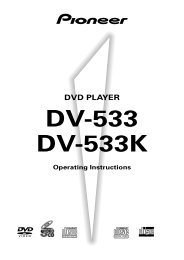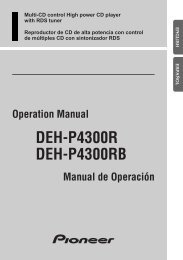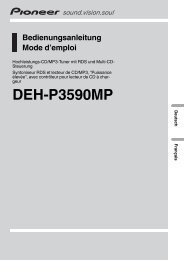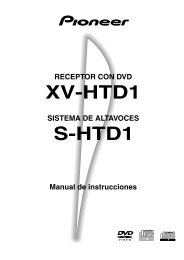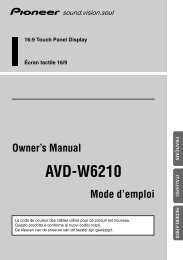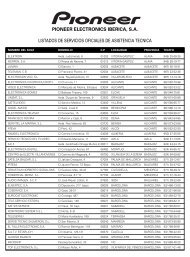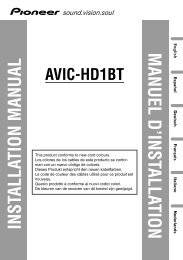Setting Up your XV-DV313 DVD/CD Receiver - Service.pioneer-eur ...
Setting Up your XV-DV313 DVD/CD Receiver - Service.pioneer-eur ...
Setting Up your XV-DV313 DVD/CD Receiver - Service.pioneer-eur ...
Create successful ePaper yourself
Turn your PDF publications into a flip-book with our unique Google optimized e-Paper software.
<strong>CD</strong><br />
STANDBY/ON<br />
FM/AM<br />
<strong>DVD</strong> TUNER TV LINE<br />
DISPLAY<br />
<strong>DVD</strong> MENU<br />
MUTE<br />
CH<br />
TUNE+<br />
ST–<br />
ST+<br />
ENTER<br />
TUNE–<br />
TV CONTROL<br />
INPUT<br />
OPEN<br />
L1/L2<br />
OPEN CLOSE<br />
RETURN<br />
SOUND<br />
VOL<br />
SPEAKERS<br />
L<br />
R<br />
FRONT CENTER SURROUND<br />
6 6 6<br />
6 6 6<br />
SUB<br />
WOOFER<br />
L<br />
R<br />
IN<br />
IN<br />
TV AUDIO LINE 1<br />
OUT<br />
L<br />
R<br />
AC IN<br />
OPTICAL IN<br />
AUDIO<br />
LINE 2<br />
VIDEO<br />
OUT<br />
VIDEO<br />
AV CONNECTOR<br />
ANTENNA FM<br />
UNBAL 75Ω<br />
AM<br />
LOOP ANTENNA<br />
<strong>Setting</strong> <strong>Up</strong> <strong>your</strong> <strong>XV</strong>-<strong>DV313</strong> <strong>DVD</strong>/<strong>CD</strong> <strong>Receiver</strong><br />
1<br />
Check that you have all the accessories, then put<br />
the batteries in the remote control.<br />
AM loop antenna<br />
3<br />
Power cord *<br />
* In some countries or regions, the shape of the<br />
power plug may sometimes differ from that<br />
shown in the explanatory drawings.<br />
When connecting this system or changing connections, be sure to switch the power off with the STANDBY/ON button, and disconnect the power cord from the AC outlet.<br />
Do not use these speakers with any other system or amplifier as this may result in damage or fire.<br />
Video cord<br />
FM antenna<br />
Batteries and<br />
remote control<br />
Satellite speakers: • Center (1)<br />
• Front/Surround (x4)<br />
• Subwoofer (1)<br />
• Speaker cords (x6)<br />
• Non-slip pads (x24)<br />
1 2 3<br />
Connect each speaker using the color-coded<br />
speaker cords. Match them to the colored labels<br />
above the speaker terminals.<br />
* Illustration shows the European model<br />
1<br />
4<br />
SPEAKERS<br />
L<br />
R<br />
8<br />
3<br />
7<br />
MASTER<br />
VOLUME<br />
0<br />
¡<br />
4<br />
FRONT CENTER SURROUND<br />
6 6 6<br />
6 6 6<br />
SUB<br />
WOOFER<br />
L<br />
R<br />
IN<br />
IN<br />
TV AUDIO LINE 1<br />
2<br />
OUT<br />
L<br />
R<br />
1<br />
2<br />
3<br />
Connect the AM and FM antennas to the rear panel of the <strong>DVD</strong>/<strong>CD</strong> receiver.<br />
Pull off the protective<br />
shields of both AM antenna<br />
wires.<br />
Push open the tabs, then insert<br />
one wire fully into each terminal.<br />
Release the tabs to secure the AM<br />
antenna wires.<br />
4 Fix the AM loop antenna to the<br />
attached stand.<br />
To fix the stand to the antenna, bend in the<br />
direction indicated by the arrow (fig. A) then<br />
clip the loop onto the stand (fig. B).<br />
Note: If you plan to mount the AM antenna<br />
to a wall or other surface, secure the stand<br />
with screws (fig. C) before clipping the loop<br />
to the stand. Make sure the reception is clear.<br />
5 Place the AM antenna on a flat<br />
surface and point in the direction<br />
giving the best reception.<br />
Don’t let it come into contact with metal<br />
objects and avoid placing near computers,<br />
television sets or other electrical appliances.<br />
6<br />
Surround right<br />
(Grey)<br />
Listening position<br />
6<br />
Surround left<br />
(Blue)<br />
ANTENNA FM<br />
UNBAL 75Ω<br />
ANTENNA<br />
Subwoofer (Purple)<br />
AM<br />
LOOP ANTENNA<br />
European model<br />
FM<br />
UNBAL 75Ω<br />
AM<br />
LOOP ANTENNA<br />
All other models<br />
4<br />
fig. A fig. B fig. C<br />
1<br />
Connect the FM wire antenna to the FM UNBAL 75Ω antenna terminal.<br />
For best results, extend the FM antenna fully and fix to a wall or door<br />
frame. Don’t drape loosely or leave coiled up.<br />
Note: The signal earth (H) is designed to reduce noise that occurs when an<br />
antenna is connected. It is not an electrical safety earth.<br />
Connect each speaker as shown below.<br />
1<br />
2<br />
2<br />
3<br />
Color-coded wire<br />
(Connect to speaker)<br />
Color-coded connector<br />
(Connect to rear panel)<br />
Twist and pull off the protective<br />
shields on each wire.<br />
Connect the wires to the<br />
speaker. Match the colored<br />
wire with the color-coded<br />
label (above the tabs), then<br />
insert the colored wire into<br />
the red (+) tab and the other<br />
wire with the black (–) tab.<br />
Using the remote control<br />
The remote control can be used within a range of about 7 meters from the remote sensor on the front panel, and within a<br />
30 degree angle.<br />
Precautions:<br />
• The remote control may not work if there is an obstacle between the remote control and the display unit, or if the remote<br />
control is not directed towards the remote sensor of the display unit at the correct angle.<br />
• The remote control may not work properly if strong light such as direct sunlight or fluorescent light is shining onto the<br />
unit’s remote sensor.<br />
• The remote control may not work properly when this unit is used near devices emitting infrared rays, or when remote<br />
controls of other devices which use infrared rays are used. Also, the use of this remote control may cause other devices to<br />
work improperly.<br />
• When the operating range of the remote becomes too short, replace the batteries.<br />
Remote control battery caution<br />
Incorrect use of batteries may cause leakage or rupture.<br />
Always be sure to follow these guidelines:<br />
• Always insert batteries into the battery compartment correctly matching the<br />
positive ª and negative · polarities, as shown by the display inside the compartment.<br />
• Never mix new and used batteries.<br />
• Batteries of the same size may have different voltages, depending on brand. Do not mix different brands of batteries.<br />
• When disposing of used batteries, please comply with governmental regulations or environmental public instruction's rules<br />
that apply in <strong>your</strong> country or area.<br />
• In order to prevent battery leakage, remove the batteries when not using the remote control for an extended period (one<br />
month or more). If leakage occurs, carefully wipe away any battery fluid inside the compartment, and replace the batteries<br />
with new ones.<br />
• Do not allow books or other objects to rest on top of the remote control, since the buttons may be depressed, causing<br />
faster exhaustion of the batteries.<br />
Additional notes on connecting antennas<br />
• Keep antenna cables away from other cables and the display unit and main set.<br />
• To assure optimum reception, pull the FM antenna so that it is fully extended and not coiled or hanging at the rear of the unit.<br />
• If reception with the supplied antenna is poor, see the Additional Connections section in the main operating instructions<br />
for details on connecting outdoor antennas.<br />
Additional notes on speaker placement<br />
Place speakers as shown in step 4 to achieve the optimum surround sound effect<br />
• Install the main front left and right speakers at an equal distance from the TV.<br />
• For optimum effect, install the rear speakers slightly above ear level.<br />
• This system's speakers are magnetically shielded, so there's virtually no picture color distortion when they are placed near<br />
a TV. In the rare event that there is some picture color interference, switch power to the TV off, and wait 15 to 30 minutes<br />
before switching on again.<br />
• Install the center speaker above or below the TV so that the sound of the center channel is localized at the TV screen.<br />
• When installing the center speaker on top of the TV, be sure to secure it with tape or some other suitable means.<br />
Otherwise, the speaker may fall from the TV due to external shocks such as earthquakes, endangering those nearby or<br />
damaging the speaker.<br />
• Do not connect the supplied speakers with any other amplifier. This may result in malfunction or fire.<br />
4<br />
Connect the <strong>DVD</strong>/<strong>CD</strong> receiver to <strong>your</strong> TV, then connect the<br />
supplied power cord.<br />
1<br />
2<br />
Connect one end to a video input on <strong>your</strong> TV.<br />
Use the supplied video cord.<br />
Connect the other end to the video output of the <strong>DVD</strong>/<strong>CD</strong> receiver.<br />
This player is equipped with copy protection technology. Do not connect this<br />
player to <strong>your</strong> TV via a VCR using AV cables, as the picture from this player will not<br />
appear properly on <strong>your</strong> TV.<br />
3 Connect the power cord to the AC inlet.<br />
VIDEO IN<br />
Front right<br />
(Red)<br />
Center (Green)<br />
Front left<br />
(White)<br />
3<br />
Connect the other end to the<br />
color-coded speaker jacks on<br />
the rear of the <strong>DVD</strong>/<strong>CD</strong><br />
receiver (as shown at left).<br />
Make sure to insert completely.<br />
* Illustration shows the European model<br />
VIDEO<br />
OUT<br />
VIDEO<br />
For the best surround sound, setup <strong>your</strong><br />
speakers as above. The front left and right<br />
speakers should be about 1.8–2.7 m apart.<br />
Remove the supplied non-slip pads from the paper, and stick four<br />
onto the base of each satellite speaker.<br />
Actual speakers supplied may differ from those shown.<br />
These speaker terminals can be hazardous when live. When you connect or<br />
disconnect the speaker cables, to prevent the risk of electric shock, do not<br />
touch uninsulated parts before disconnecting the power cord.<br />
AC IN<br />
Congratulations! You're done setting up.<br />
To AC outlet<br />
Printed in<br />
<strong>CD</strong><br />
ST–<br />
STANDBY/ON<br />
FM/AM<br />
<strong>DVD</strong> TUNER TV LINE<br />
DISPLAY<br />
<strong>DVD</strong> MENU<br />
MUTE<br />
CH<br />
TUNE+<br />
ENTER<br />
TUNE–<br />
TV CONTROL<br />
INPUT<br />
OPEN<br />
ST+<br />
L1/L2<br />
OPEN CLOSE<br />
RETURN<br />
SOUND<br />
VOL<br />
SPEAKERS<br />
L<br />
R<br />
FRONT CENTER SURROUND<br />
6 6 6<br />
6 6 6<br />
SUB<br />
WOOFER<br />
L<br />
R<br />
IN<br />
IN<br />
TV AUDIO LINE 1<br />
OUT<br />
L<br />
R<br />
AC IN<br />
OPTICAL IN<br />
AUDIO<br />
LINE 2<br />
VIDEO<br />
OUT<br />
VIDEO<br />
AV CONNECTOR<br />
ANTENNA FM<br />
UNBAL 75Ω<br />
AM<br />
LOOP ANTENNA<br />
Configuration de votre récept<strong>eur</strong> <strong>XV</strong>-<strong>DV313</strong> <strong>DVD</strong>/<strong>CD</strong><br />
1<br />
Vérifiez que vous avez tous les accessoires,<br />
puis mettez les piles dans la télécommande.<br />
Antenne cadre AM<br />
3<br />
Attention<br />
1<br />
Cordon d’alimentation<br />
Cordon vidéo<br />
Antenne FM<br />
Au raccordement de ce système ou aux changements de connexions, vérifiez d’éteindre avec la touche STANDBY/ON, et de débrancher le cordon d’alimentation de la prise de courant sect<strong>eur</strong>.<br />
N’utilisez pas ces enceintes avec un tout autre système ou amplificat<strong>eur</strong> puisque cela pourrait entraîner des dommages ou un incendie.<br />
Piles et<br />
télécommande<br />
Enceintes satellites : • Centrale (1)<br />
• Avant/Surround (x4)<br />
• Subwoofer (1)<br />
• Cordons d’enceinte (x6)<br />
• Tampons<br />
anti-dérapants (x24)<br />
2 3<br />
Raccordez chaque enceinte en utilisant les cordons<br />
d’enceinte codés par coul<strong>eur</strong>. Faites-les correspondre<br />
avec les étiquettes de coul<strong>eur</strong> situées au-dessus des<br />
bornes d’enceintes.<br />
1<br />
4<br />
SPEAKERS<br />
L<br />
R<br />
8<br />
3<br />
7<br />
MASTER<br />
VOLUME<br />
0<br />
¡<br />
4<br />
FRONT CENTER SURROUND<br />
6 6 6<br />
6 6 6<br />
SUB<br />
WOOFER<br />
L<br />
R<br />
IN<br />
IN<br />
2<br />
TV AUDIO LINE 1<br />
OUT<br />
1<br />
2<br />
3<br />
4<br />
Raccordez les antennes AM et FM au panneau arrière du récept<strong>eur</strong> <strong>DVD</strong>/<strong>CD</strong>.<br />
Retirez les capuchons de protection<br />
des deux fils de l’antenne AM.<br />
Ouvrez en poussant sur les<br />
languettes, puis insérez<br />
complètement un fil dans chaque<br />
borne.<br />
Relâchez les languettes pour fixer les<br />
fils de l’antenne AM.<br />
Fixez l’antenne cadre AM au support<br />
qui est joint.<br />
Pour fixer le support de l’antenne, pliez-le dans<br />
le sens indiqué par la flèche (fig. A) puis<br />
accrochez le cadre sur le support (fig. B).<br />
Remarque : Si vous pensez monter l’antenne<br />
AM au mur ou autre surface, fixez le support<br />
avec des vis (fig. C) avant d’accrocher le cadre<br />
au support. Vérifiez que la réception est claire.<br />
5 Placez l’antenne AM sur une surface<br />
plane et pointez-la vers la direction<br />
qui offre la meill<strong>eur</strong>e réception.<br />
6 Raccordez l’antenne filaire FM à la borne d’antenne FM UNBAL 75Ω.<br />
Pour obtenir de meill<strong>eur</strong>s résultats, déployez complètement l’antenne FM et fixez-la au<br />
mur ou au cadre d’une porte. Ne la laissez pas pendre lâchement ou déroulée.<br />
Ne la laissez pas entrer en contact avec des<br />
Remarque : Le signal de mise à la masse (H) est conçu pour réduire les parasites qui se<br />
objets métalliques et évitez de la placer près<br />
produisent lorsqu’une antenne est raccordée. Il ne s’agit pas d’une masse de sécurité<br />
d’ordinat<strong>eur</strong>s, de télévis<strong>eur</strong>s ou autres appareils<br />
électrique.<br />
électriques.<br />
L<br />
R<br />
Surround droite<br />
(Gris)<br />
Position d’écoute<br />
6<br />
Surround gauche<br />
(Bleu)<br />
Subwoofer (violette)<br />
ANTENNA<br />
FM<br />
UNBAL 75Ω<br />
AM<br />
LOOP ANTENNA<br />
4<br />
fig. A fig. B fig. C<br />
Raccordez chaque enceinte comme indiqué ci-dessous.<br />
Fil codé par coul<strong>eur</strong><br />
(Raccordez à l’enceinte)<br />
Fil codé par coul<strong>eur</strong><br />
(Raccordez au panneau arrière)<br />
1<br />
1<br />
2<br />
2<br />
3<br />
Torsadez et retirez les capuchons de<br />
protection sur chaque fil.<br />
Raccordez une extrémité à l’enceinte.<br />
Faites correspondre le fil coloré avec<br />
l’étiquette codée par coul<strong>eur</strong> (au-dessus<br />
des languettes), puis insérez le fil coloré<br />
dans la languette rouge (+) et l’autre fil<br />
dans la languette noire (–).<br />
Utilisation de la télécommande<br />
La télécommande peut s’utiliser dans une portée d’environ 7 mètres depuis le capt<strong>eur</strong> de télécommande situé sur le panneau<br />
avant, et dans un angle de 30 degrés.<br />
Précautions:<br />
• La télécommande peut ne pas fonctionner s’il y a un obstacle entre la télécommande et l’affich<strong>eur</strong>, ou si la télécommande<br />
n’est pas dirigée vers le capt<strong>eur</strong> de télécommande de l’affich<strong>eur</strong> dans un angle correct.<br />
• La télécommande peut ne pas fonctionner correctement si une forte lumière comme la lumière du soleil ou fluorescente<br />
brille sur le capt<strong>eur</strong> de télécommande.<br />
• La télécommande peut ne pas fonctionner correctement lorsque cette unité est utilisée près de dispositifs émett<strong>eur</strong>s de<br />
rayons infrarouges, ou lorsque des télécommandes d’autres dispositifs qui emploient des rayons infrarouges sont utilisés. Aussi,<br />
l’utilisation de cette télécommande peut provoquer un mauvais fonctionnement des autres dispositifs.<br />
• Lorsque la portée opérative de la télécommande diminue, remplacez les piles.<br />
Précautions à prendre avec les piles de la télécommande<br />
L’utilisation incorrecte des piles peut provoquer une fuite ou une cassure.<br />
N’oubliez jamais de suivre ces indications:<br />
• Insérez toujours correctement les piles dans le logement à piles en faisant correspondre les polarités positive ª et négative<br />
·, comme montré par l’affichage à l’intéri<strong>eur</strong> du logement.<br />
• Ne mélangez jamais des piles neuves avec des piles usées.<br />
• Des piles de même taille peuvent avoir un voltage différent, selon la marque. Ne mélangez pas des piles de différentes marques.<br />
• En vous débarrassant des piles usées, veuillez être conforme aux réglements gouvernement aux qui s’appliquent dans votre<br />
pays ou votre zone.<br />
• De façon á éviter une fuite, retirez les piles si vous n’utilisez pas la télécommande pendant longtemps (un mois ou plus). Si<br />
une fuite se produit, essuyez soigneusement tout liquide se trouvant à l’intéri<strong>eur</strong> du logement, et remplacez les piles par des<br />
piles neuves.<br />
• Ne laissez pas de livres ou autres objets au-dessus de la télécommande, puisque les touches pourraient être pressées,<br />
provoquant ainsi une consommation plus rapide des piles.<br />
Remarques supplémentaires sur le raccordement des antennes<br />
• Maintenez éloignés les câbles d’antenne des autres câbles et de l’affich<strong>eur</strong> et du poste principal.<br />
• Pour garantir une réception optimale, mettez l’antenne FM de façon à celle qu’elle soit complètement déployée et non pas<br />
enroulée ou pendante à l’arrière de l’unité.<br />
• Si la réception avec l’antenne fournie est pauvre, voir la section Raccordements supplémentaires dans le mode d’emploi<br />
principal pour les détails sur le raccordement d’antennes extéri<strong>eur</strong>es.<br />
Remarques supplémentaires sur l’emplacement des enceintes<br />
Placez les enceintes comme montré dans l’étape 4 pour atteindre l’effet de son surround optimal.<br />
• Installez les principales enceintes avant gauche et droite à égale distance du télévis<strong>eur</strong>.<br />
• Pour obtenir un effet optimal, installez les enceintes arrière légèrement au-dessus du niveau des oreilles.<br />
• Les enceintes de ce système sont magnétiquement protégées, donc virtuellement il n’y a pas de déformation de la coul<strong>eur</strong><br />
de l’image lorsqu’elles sont placées près d’un télévis<strong>eur</strong>. Dans le rare cas où il y a quelques interférences dans la coul<strong>eur</strong> de<br />
l’image, éteignez le télévis<strong>eur</strong>, et attendez 15 à 30 minutes avant d’allumer de nouveau.<br />
• Installez l’enceinte centrale au-dessus ou au-dessous du télévis<strong>eur</strong> afin que le son du canal central soit localisé à l’écran du<br />
télévis<strong>eur</strong>.<br />
• À l’installation de l’enceinte centrale au-dessus du télévis<strong>eur</strong>, vérifiez de la fixer avec une bande ou quelque autre moyen<br />
approprié. Autrement, l’enceinte peut tomber du télévis<strong>eur</strong> suite à des chocs externes comme des tremblements de terre,<br />
mettant en danger toute personne se trouvant à proximité ou endommageant l’enceinte.<br />
• Ne raccordez pas les enceintes fournies avec un autre amplificat<strong>eur</strong> quelconque. Cela peut entraîner un mauvais<br />
fonctionnement ou un incendie.<br />
4<br />
Raccordez le récept<strong>eur</strong> <strong>DVD</strong>/<strong>CD</strong> à votre télévis<strong>eur</strong>, puis<br />
raccordez le cordon d’alimentation fourni.<br />
1<br />
2<br />
3<br />
Raccordez une extrémité à une entrée vidéo de votre télévis<strong>eur</strong>.<br />
Utilisez les fils vidéo qui vous sont fournis.<br />
Raccordez l’autre extrémité à la sortie vidéo de votre récept<strong>eur</strong> <strong>DVD</strong>/<strong>CD</strong>.<br />
Ce lect<strong>eur</strong> est doté d’une technologie de protection contre la copie. Ne connectez pas<br />
ce lect<strong>eur</strong> à votre télévis<strong>eur</strong> via un magnétoscope à l’aide de câbles AV: l’image<br />
provenant du lect<strong>eur</strong> ne s’affichera pas correctement à l’écran de votre télévis<strong>eur</strong>.<br />
Raccordez le cordon d’alimentation à la prise de courant secteu.<br />
VIDEO IN<br />
Avant droite<br />
(Rouge)<br />
Centrale (Vert)<br />
Avant gauche<br />
(Blanc)<br />
3<br />
Raccordez l’autre extrémité des prises<br />
des enceintes codées par coul<strong>eur</strong> à<br />
l’arrière du récept<strong>eur</strong> <strong>DVD</strong>/<strong>CD</strong> (comme<br />
illustré ici à gauche).<br />
Assurez-vous de bien l’insérer<br />
complètement.<br />
VIDEO<br />
OUT<br />
VIDEO<br />
Pour obtenir le meill<strong>eur</strong> son surround, installez<br />
vos enceintes comme ci-dessus. Les enceintes<br />
avant gauche et droite doivent avoir 1,8 à 2,7 m<br />
de séparation.<br />
Remarque<br />
Retirez du papier les tampons anti-dérapants fournis, et collez-en quatre<br />
sur la base de chaque enceinte satellite.<br />
Les enceintes actuellement fournies peuvent être différentes de celles<br />
qui sont montrées.<br />
Attention<br />
Ces bornes d’enceinte peuvent être dangereuses lorsqu’elles sont sous tension.<br />
Lorsque vous branchez ou débranchez les fils des hauts parl<strong>eur</strong>s, afin d'éviter les<br />
risques de décharge électrique, ne pas toucher les parties non isolées avant d'avoir<br />
débranché le raccordement d'alimentation.<br />
AC IN<br />
Félicitations ! Vous avez fait l’installation.<br />
Vers la prise de courant sect<strong>eur</strong>



